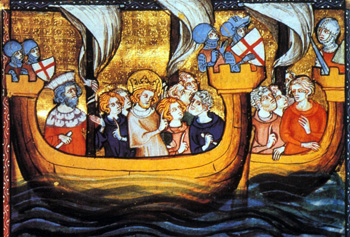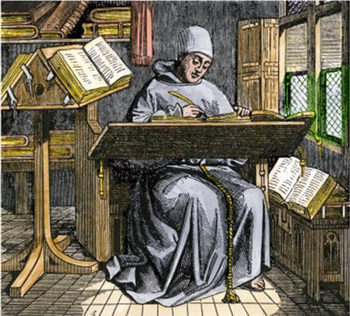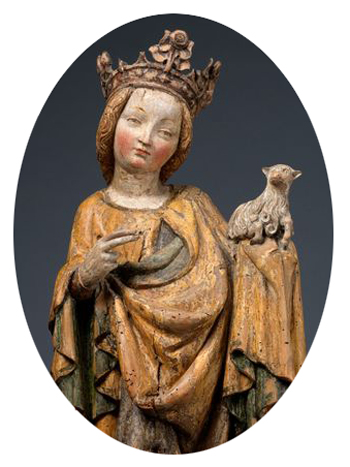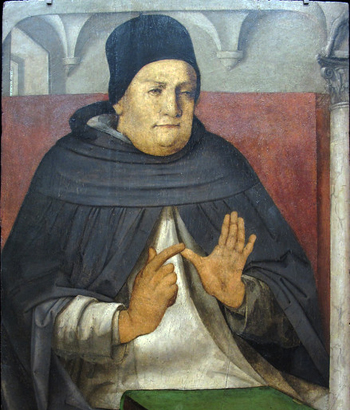Catholic Virtues
 |
 |
 |
 |
 |
 |
 |
True & False Paths to Happiness - VIII
Innocence in Centuries Past
Was innocence the chief characteristic of any historical era?
 Yes, History itself records the fact that the Middle Ages was the era when men most conserved this spirit of childhood, an observation confirmed by many historians. The medieval men were courageous, loyal, honorable and pious; they had faith. What they created with this innocent spirit has nothing in common with what we see today, even among many who believe.
Yes, History itself records the fact that the Middle Ages was the era when men most conserved this spirit of childhood, an observation confirmed by many historians. The medieval men were courageous, loyal, honorable and pious; they had faith. What they created with this innocent spirit has nothing in common with what we see today, even among many who believe.
For example, we have this picture of King St Louis IX as a Crusader: "Arrayed in gold armor, he was taller than any of the men in his army. When he reached the place of the battle, he jumped into the waters of the Mediterranean and rushed eagerly to the beach, filled with enthusiasm."
A King who jumps out of his ship and is the first to land for battle!
And what about the innocence of St. Thomas Aquinas? He was completely logical in his thinking and at the same time had a full faith; he achieved the perfect harmony between logic and faith. And he soared – for what he did was no longer walking, but flying – in the horizons of reasoning with the purity of a seraph. His logic is as pure as the blue, red or gold in the stained glass of a cathedral's window. In him, the concepts of purity, sublimity and radicality come together.
Here we have two grand figures: a King, a hero and a Saint, and a Doctor, a luminary of theology and philosophy. Is this also true for those in more humble stations of life? Yes, it is. Indeed, we can admire the innocence of a simple medieval copyist.
Placidity of the copyist at work
Here, for example, we see a medieval man copying a book, obviously a professional copyist, some of whom were real artists.
Sitting at a table by the window, he is dressed in an ample gray robe that covers him fully and allows him free movement of body. To his left is a window with stained glass plates, green in color, slightly transparent, closed in such a way that the light penetrate it from left to right, thus illuminating his work as it should.
He, seated with a placid face, is writing with a large duck feather.
 Thus the copyist tranquilly labored, a beautiful work in which, we perceive, he was skilled. No rush, no anxiety, no tiredness. We see that he was extremely content. Following his profession and satisfied.
Thus the copyist tranquilly labored, a beautiful work in which, we perceive, he was skilled. No rush, no anxiety, no tiredness. We see that he was extremely content. Following his profession and satisfied.
But content with what? With that ambience that expresses some moral values, for example, a placidity in work. Placidity itself is a moral quality. A placidity in work unites two opposing but harmonic perfections, for placidity can seem to be the opposite of action.
This copyist has no notion of a day that went extraordinarily well. It was a normal day for him. This normality was not entertaining or exciting, it was just a normal pleasant day. To experience elation and delight are exceptions in life. What is normal is this daily calm and simple pleasure. It is the true pleasure of a normal, tranquil and placid life.
In the Middle Ages, this innocent idealism permeated all the social classes, as we can read in descriptions of the building of Chartres Cathedral in the 12th century. An English author wrote:
"The faithful harnessed themselves to the carts that carried the stones and pulled them from the quarries to the Cathedral. Their enthusiasm spread throughout the country. Men and women came from afar, loaded with heavy packages of provisions for the workers: wine, oil and wheat. Noble lords and ladies pulled the carts like everyone else. The discipline was perfect and the silence profound. All hearts were united and each forgave his enemies ” (Kenneth Clark, "Civilization," apud Painton Cowen, Roses Medievales, Paris: Seuil, 1979, p. 13).
Innocence will be the cornerstone of future centuries
Innocence is not a passive, resigned, inert state of mind. On the contrary, it engenders an active, lively and entrepreneurial spirit.
 Innocence is always seeking something, something that is filled with light, peace, order, concatenation and strength, and also replete with tranquility. This results in something that has the ability to move everything without itself being moved.
Innocence is always seeking something, something that is filled with light, peace, order, concatenation and strength, and also replete with tranquility. This results in something that has the ability to move everything without itself being moved.
It has something ineffable, divine, interior and secret; it must, therefore, be the light and the glory, the fundamental mark and cornerstone of future centuries. Innocence has to enlighten all of mankind; it has to inspire philosophical systems, institutions and customs; it has to animate the schools of art, and, even more than that, it has to inspire Saints and give the Church new and more brilliant days of glory.
This innocence of the future will be the reflection of the gaze, the smile and the majesty of Our Lady. It is something that will become visible in the Reign of Mary, according to the prophecies of St. Louis Maria Grignion de Montfort.
Continued


Innocent souls of the Middle Ages: The Crusader King Louis IX & St. Thomas Aquinas

For example, we have this picture of King St Louis IX as a Crusader: "Arrayed in gold armor, he was taller than any of the men in his army. When he reached the place of the battle, he jumped into the waters of the Mediterranean and rushed eagerly to the beach, filled with enthusiasm."
A King who jumps out of his ship and is the first to land for battle!
And what about the innocence of St. Thomas Aquinas? He was completely logical in his thinking and at the same time had a full faith; he achieved the perfect harmony between logic and faith. And he soared – for what he did was no longer walking, but flying – in the horizons of reasoning with the purity of a seraph. His logic is as pure as the blue, red or gold in the stained glass of a cathedral's window. In him, the concepts of purity, sublimity and radicality come together.
Here we have two grand figures: a King, a hero and a Saint, and a Doctor, a luminary of theology and philosophy. Is this also true for those in more humble stations of life? Yes, it is. Indeed, we can admire the innocence of a simple medieval copyist.
Placidity of the copyist at work
Here, for example, we see a medieval man copying a book, obviously a professional copyist, some of whom were real artists.
Sitting at a table by the window, he is dressed in an ample gray robe that covers him fully and allows him free movement of body. To his left is a window with stained glass plates, green in color, slightly transparent, closed in such a way that the light penetrate it from left to right, thus illuminating his work as it should.
He, seated with a placid face, is writing with a large duck feather.

The medieval copyist at work
But content with what? With that ambience that expresses some moral values, for example, a placidity in work. Placidity itself is a moral quality. A placidity in work unites two opposing but harmonic perfections, for placidity can seem to be the opposite of action.
This copyist has no notion of a day that went extraordinarily well. It was a normal day for him. This normality was not entertaining or exciting, it was just a normal pleasant day. To experience elation and delight are exceptions in life. What is normal is this daily calm and simple pleasure. It is the true pleasure of a normal, tranquil and placid life.
In the Middle Ages, this innocent idealism permeated all the social classes, as we can read in descriptions of the building of Chartres Cathedral in the 12th century. An English author wrote:
"The faithful harnessed themselves to the carts that carried the stones and pulled them from the quarries to the Cathedral. Their enthusiasm spread throughout the country. Men and women came from afar, loaded with heavy packages of provisions for the workers: wine, oil and wheat. Noble lords and ladies pulled the carts like everyone else. The discipline was perfect and the silence profound. All hearts were united and each forgave his enemies ” (Kenneth Clark, "Civilization," apud Painton Cowen, Roses Medievales, Paris: Seuil, 1979, p. 13).
Innocence will be the cornerstone of future centuries
Innocence is not a passive, resigned, inert state of mind. On the contrary, it engenders an active, lively and entrepreneurial spirit.

A medieval statue of Our Lady
It has something ineffable, divine, interior and secret; it must, therefore, be the light and the glory, the fundamental mark and cornerstone of future centuries. Innocence has to enlighten all of mankind; it has to inspire philosophical systems, institutions and customs; it has to animate the schools of art, and, even more than that, it has to inspire Saints and give the Church new and more brilliant days of glory.
This innocence of the future will be the reflection of the gaze, the smile and the majesty of Our Lady. It is something that will become visible in the Reign of Mary, according to the prophecies of St. Louis Maria Grignion de Montfort.
Continued

Posted April 22, 2020





